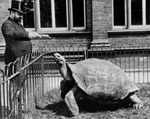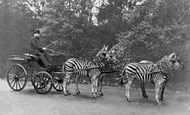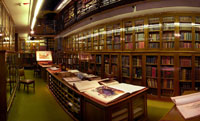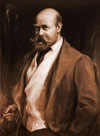|
The Zoological Museum has been part of the Natural History Museum since 1937, but it was once the private museum of Lionel Walter, 2nd Baron Rothschild, who moved with his family to Tring Park in 1872. Lionel Walter Rothschild was born in 1868, the eldest son of Nathan Mayer, 1st Baron Rothschild of Tring, head of the distinguished firm of merchant bankers NM Rothschild & Sons and Member of Parliament for Aylesbury . .
As a child Walter Rothschild knew exactly what he was going to do when he grew up, announcing at the age of seven, 'Mama, Papa, I am going to make a museum...'. He had already started collecting insects and stuffed animals by then, and a year later started setting his own collection of butterflies. By the time he was ten, Walter had enough natural history objects to start his first museum - in a garden shed!
Before long Walter's insect and bird collections were so large that they had to be stored in rented rooms and sheds around Tring. Then in 1889, when Walter Rothschild was 21, his father gave him some land on the outskirts of Tring Park. Two small cottages were built, one to house his books and insect collection, the other for a caretaker. Behind these was a much larger building, which would contain Lord Rothschild's collection of mounted specimens. This was the beginning of the Zoological Museum, which opened to the public in 1892, and the beginning of Lord Rothschild's life-long passion for natural history.
Walter Rothschild also kept livestock in the grounds around the Museum and in Tring Park, including zebra, a tame wolf, rheas, marabou stork, a dingo, kangaroos, kiwis, cassowaries and giant tortoises. He was probably considered a little eccentric by many of his contemporaries - especially when he drove a team of zebras into the forecourt of Buckingham Palace! Walter's brother later commented that the zebra's camouflage was so good that half way there they seemed to vanish, leaving Walter riding along Piccadilly in a horseless carriage. 
New material accumulated at the Museum so rapidly that Lord Rothschild and his curators, Ernst Hartert and Karl Jordan, began to issue the Museum's own scientific journal, Novitates Zoologicae, in 1894. Over the course of 45 years they published more than 1,700 scientific books and papers, and described more than 5,000 new species of animals. Many of these publications can still be found in the Museum library today. The library is considered to be one of the finest ornithological libraries in the world. Augmented by The Natural History Museum's ornithological collection, it contains many of Rothschild's own monographs, along with books by John Gould and Edward Lear.
By the time Lord Rothschild died his collections included some 2,000 mounted mammals and a similar number of mounted birds, along with two million butterflies and moths, 300,000 bird skins, 144 giant tortoises, 200,000 birds' eggs and 30,000 relevant books. He selected the finest specimens for display and made sure they were prepared by experts. As a result many of the specimens on display today are outstanding examples of nineteenth-century taxidermy at its very best and every attempt has been made to preserve the character and general arrangement of Lord Rothschild's museum. number of mounted birds, along with two million butterflies and moths, 300,000 bird skins, 144 giant tortoises, 200,000 birds' eggs and 30,000 relevant books. He selected the finest specimens for display and made sure they were prepared by experts. As a result many of the specimens on display today are outstanding examples of nineteenth-century taxidermy at its very best and every attempt has been made to preserve the character and general arrangement of Lord Rothschild's museum.
|
|
